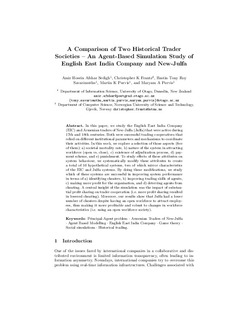| dc.contributor.author | Sedigh, Amir Hosein Afshar | |
| dc.contributor.author | Frantz, Christopher | |
| dc.contributor.author | Savarimuthu, Bastin Tony Roy | |
| dc.contributor.author | Purvis, Martin K | |
| dc.contributor.author | Purvis, Maryam A | |
| dc.date.accessioned | 2019-11-04T14:10:34Z | |
| dc.date.available | 2019-11-04T14:10:34Z | |
| dc.date.created | 2019-08-20T12:29:32Z | |
| dc.date.issued | 2019 | |
| dc.identifier.citation | Lecture Notes in Computer Science. 2019, 11463 LNAI 17-31. | nb_NO |
| dc.identifier.issn | 0302-9743 | |
| dc.identifier.uri | http://hdl.handle.net/11250/2626440 | |
| dc.description.abstract | In this paper, we study the English East India Company (EIC) and Armenian traders of New-Julfa (Julfa) that were active during 17th and 18th centuries. Both were successful trading cooperatives that relied on different institutional parameters and mechanisms to coordinate their activities. In this work, we explore a selection of those aspects (five of them): (a) societal mortality rate, (b) nature of the system in attracting workforce (open vs. close), (c) existence of adjudication process, (d) payment scheme, and (e) punishment. To study effects of these attributes on system behaviour, we systematically modify these attributes to create a total of 10 hypothetical systems, two of which mirror characteristics of the EIC and Julfa systems. By doing these modifications, we study which of these systems are successful in improving system performance in terms of (a) identifying cheaters, (b) improving trading skills of agents, (c) making more profit for the organisation, and (d) deterring agents from cheating. A central insight of the simulation was the impact of substantial profit sharing on trader cooperation (i.e. more profit sharing resulted in lowered cheating). Moreover, our results show that Julfa had a lower number of cheaters despite having an open workforce to attract employees, thus making it more profitable and robust to changes in workforce characteristics (i.e. using an open workforce society). | nb_NO |
| dc.language.iso | eng | nb_NO |
| dc.publisher | Springer Verlag | nb_NO |
| dc.title | A Comparison of Two Historical Trader Societies – An Agent-Based Simulation Study of English East India Company and New-Julfa | nb_NO |
| dc.type | Journal article | nb_NO |
| dc.type | Peer reviewed | nb_NO |
| dc.description.version | acceptedVersion | nb_NO |
| dc.source.pagenumber | 17-31 | nb_NO |
| dc.source.volume | 11463 LNAI | nb_NO |
| dc.source.journal | Lecture Notes in Computer Science | nb_NO |
| dc.identifier.doi | 10.1007/978-3-030-22270-3_2 | |
| dc.identifier.cristin | 1717360 | |
| dc.description.localcode | This is a post-peer-review, pre-copyedit version of an article published in [Lecture Notes in Computer Science] Locked until 20.6.2020 due to copyright restrictions. The final authenticated version is available online at: https://doi.org/10.1007/978-3-030-22270-3_2 | nb_NO |
| cristin.unitcode | 194,63,10,0 | |
| cristin.unitname | Institutt for datateknologi og informatikk | |
| cristin.ispublished | true | |
| cristin.fulltext | preprint | |
| cristin.qualitycode | 1 | |
